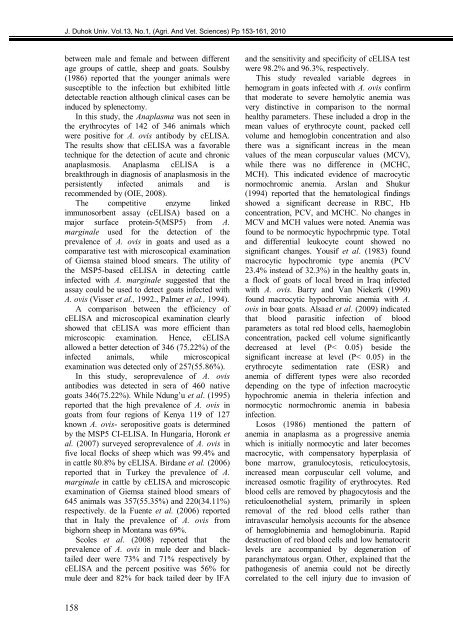The Influence Of Priming Two Cucumber Cultivar Seeds
The Influence Of Priming Two Cucumber Cultivar Seeds
The Influence Of Priming Two Cucumber Cultivar Seeds
You also want an ePaper? Increase the reach of your titles
YUMPU automatically turns print PDFs into web optimized ePapers that Google loves.
J. Duhok Univ. Vol.13, No.1, (Agri. And Vet. Sciences) Pp 153-161, 2010<br />
between male and female and between different<br />
age groups of cattle, sheep and goats. Soulsby<br />
(1986) reported that the younger animals were<br />
susceptible to the infection but exhibited little<br />
detectable reaction although clinical cases can be<br />
induced by splenectomy.<br />
In this study, the Anaplasma was not seen in<br />
the erythrocytes of 142 of 346 animals which<br />
were positive for A. ovis antibody by cELISA.<br />
<strong>The</strong> results show that cELISA was a favorable<br />
technique for the detection of acute and chronic<br />
anaplasmosis. Anaplasma cELISA is a<br />
breakthrough in diagnosis of anaplasmosis in the<br />
persistently infected animals and is<br />
recommended by (OIE, 2008).<br />
<strong>The</strong> competitive enzyme linked<br />
immunosorbent assay (cELISA) based on a<br />
major surface protein-5(MSP5) from A.<br />
marginale used for the detection of the<br />
prevalence of A. ovis in goats and used as a<br />
comparative test with microscopical examination<br />
of Giemsa stained blood smears. <strong>The</strong> utility of<br />
the MSP5-based cELISA in detecting cattle<br />
infected with A. marginale suggested that the<br />
assay could be used to detect goats infected with<br />
A. ovis (Visser et al., 1992., Palmer et al., 1994).<br />
A comparison between the efficiency of<br />
cELISA and microscopical examination clearly<br />
showed that cELISA was more efficient than<br />
microscopic examination. Hence, cELISA<br />
allowed a better detection of 346 (75.22%) of the<br />
infected animals, while microscopical<br />
examination was detected only of 257(55.86%).<br />
In this study, seroprevalence of A. ovis<br />
antibodies was detected in sera of 460 native<br />
goats 346(75.22%). While Ndung’u et al. (1995)<br />
reported that the high prevalence of A. ovis in<br />
goats from four regions of Kenya 119 of 127<br />
known A. ovis- seropositive goats is determined<br />
by the MSP5 CI-ELISA. In Hungaria, Horonk et<br />
al. (2007) surveyed seroprevalence of A. ovis in<br />
five local flocks of sheep which was 99.4% and<br />
in cattle 80.8% by cELISA. Birdane et al. (2006)<br />
reported that in Turkey the prevalence of A.<br />
marginale in cattle by cELISA and microscopic<br />
examination of Giemsa stained blood smears of<br />
645 animals was 357(55.35%) and 220(34.11%)<br />
respectively. de la Fuente et al. (2006) reported<br />
that in Italy the prevalence of A. ovis from<br />
bighorn sheep in Montana was 69%.<br />
Scoles et al. (2008) reported that the<br />
prevalence of A. ovis in mule deer and black-<br />
tailed deer were 73% and 71% respectively by<br />
cELISA and the percent positive was 56% for<br />
mule deer and 82% for back tailed deer by IFA<br />
158<br />
and the sensitivity and specificity of cELISA test<br />
were 98.2% and 96.3%, respectively.<br />
This study revealed variable degrees in<br />
hemogram in goats infected with A. ovis confirm<br />
that moderate to severe hemolytic anemia was<br />
very distinctive in comparison to the normal<br />
healthy parameters. <strong>The</strong>se included a drop in the<br />
mean values of erythrocyte count, packed cell<br />
volume and hemoglobin concentration and also<br />
there was a significant increas in the mean<br />
values of the mean corpuscular values (MCV),<br />
while there was no difference in (MCHC,<br />
MCH). This indicated evidence of macrocytic<br />
normochromic anemia. Arslan and Shukur<br />
(1994) reported that the hematological findings<br />
showed a significant decrease in RBC, Hb<br />
concentration, PCV, and MCHC. No changes in<br />
MCV and MCH values were noted. Anemia was<br />
found to be normocytic hypochrpmic type. Total<br />
and differential leukocyte count showed no<br />
significant changes. Yousif et al. (1983) found<br />
macrocytic hypochromic type anemia (PCV<br />
23.4% instead of 32.3%) in the healthy goats in,<br />
a flock of goats of local breed in Iraq infected<br />
with A. ovis. Barry and Van Niekerk (1990)<br />
found macrocytic hypochromic anemia with A.<br />
ovis in boar goats. Alsaad et al. (2009) indicated<br />
that blood parasitic infection of blood<br />
parameters as total red blood cells, haemoglobin<br />
concentration, packed cell volume significantly<br />
decreased at level (P< 0.05) beside the<br />
significant increase at level (P< 0.05) in the<br />
erythrocyte sedimentation rate (ESR) and<br />
anemia of different types were also recorded<br />
depending on the type of infection macrocytic<br />
hypochromic anemia in theleria infection and<br />
normocytic normochromic anemia in babesia<br />
infection.<br />
Losos (1986) mentioned the pattern of<br />
anemia in anaplasma as a progressive anemia<br />
which is initially normocytic and later becomes<br />
macrocytic, with compensatory hyperplasia of<br />
bone marrow, granulocytosis, reticulocytosis,<br />
increased mean corpuscular cell volume, and<br />
increased osmotic fragility of erythrocytes. Red<br />
blood cells are removed by phagocytosis and the<br />
reticuloenothelial system, primarily in spleen<br />
removal of the red blood cells rather than<br />
intravascular hemolysis accounts for the absence<br />
of hemoglobinemia and hemoglobinuria. Rapid<br />
destruction of red blood cells and low hematocrit<br />
levels are accompanied by degeneration of<br />
paranchymatous organ. Other, explained that the<br />
pathogenesis of anemia could not be directly<br />
correlated to the cell injury due to invasion of



